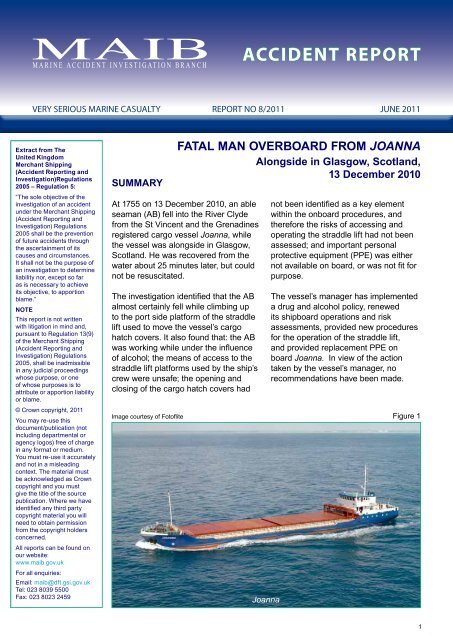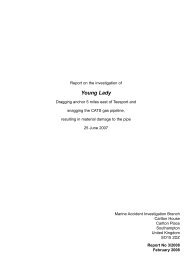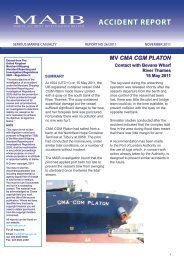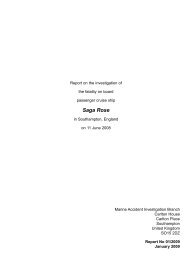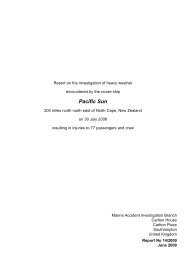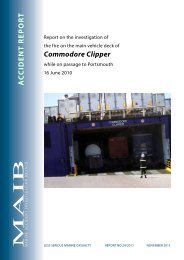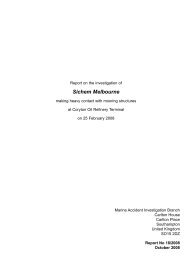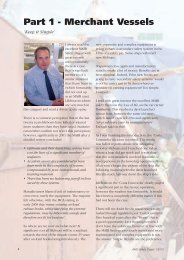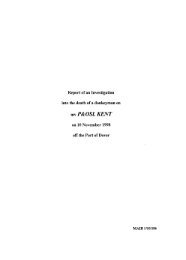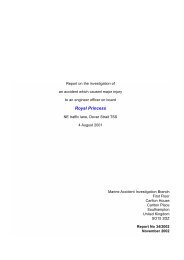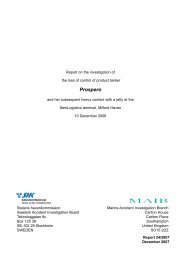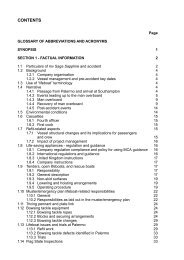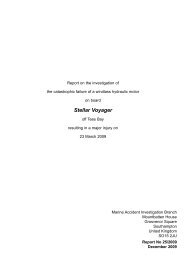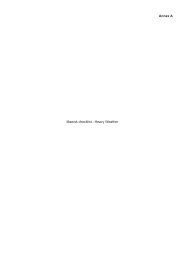ACCIDENT REPORT - Marine Accident Investigation Branch
ACCIDENT REPORT - Marine Accident Investigation Branch
ACCIDENT REPORT - Marine Accident Investigation Branch
Create successful ePaper yourself
Turn your PDF publications into a flip-book with our unique Google optimized e-Paper software.
M A R I N E A C C I D E N T I N V E S T I G A T I O N B R A N C H<br />
<strong>ACCIDENT</strong> <strong>REPORT</strong><br />
VERY SERIOUS MARINE CASUALTY <strong>REPORT</strong> NO 8/2011 JUNE 2011<br />
Extract from The<br />
United Kingdom<br />
Merchant Shipping<br />
(<strong>Accident</strong> Reporting and<br />
<strong>Investigation</strong>)Regulations<br />
2005 – Regulation 5:<br />
“The sole objective of the<br />
investigation of an accident<br />
under the Merchant Shipping<br />
(<strong>Accident</strong> Reporting and<br />
<strong>Investigation</strong>) Regulations<br />
2005 shall be the prevention<br />
of future accidents through<br />
the ascertainment of its<br />
causes and circumstances.<br />
It shall not be the purpose of<br />
an investigation to determine<br />
liability nor, except so far<br />
as is necessary to achieve<br />
its objective, to apportion<br />
blame.”<br />
NOTE<br />
This report is not written<br />
with litigation in mind and,<br />
pursuant to Regulation 13(9)<br />
of the Merchant Shipping<br />
(<strong>Accident</strong> Reporting and<br />
<strong>Investigation</strong>) Regulations<br />
2005, shall be inadmissible<br />
in any judicial proceedings<br />
whose purpose, or one of<br />
whose of whose purposes is to is attribute to<br />
or attribute apportion or apportion liability or liability blame.<br />
©<br />
or<br />
Crown<br />
blame.<br />
copyright, 2011<br />
You<br />
© Crown<br />
may re-use<br />
copyright,<br />
this<br />
2011<br />
document/publication You may re-use this (not<br />
including document/publication departmental (not or<br />
agency including logos) departmental free of charge or<br />
in agency any format logos) or free medium. of charge<br />
You in any must format re-use or medium. it accurately<br />
and You not must in re-use a misleading it accurately<br />
context. and not in The a misleading material must<br />
be context. acknowledged The material as Crown must<br />
copyright be acknowledged and you as must Crown<br />
give copyright the title and of you the must source<br />
publication. give the title Where of the source we have<br />
identified publication. any Where third party we have<br />
copyright identified any material third you party will<br />
need copyright to obtain material permission you will<br />
from need the to obtain copyright permission holders<br />
concerned.<br />
from the copyright holders<br />
All<br />
concerned.<br />
reports can be found on<br />
our All reports website: can be found on<br />
www.maib.gov.uk<br />
our website:<br />
For<br />
www.maib.gov.uk<br />
all enquiries:<br />
Email:<br />
For all<br />
maib@dft.gsi.gov.uk<br />
enquiries:<br />
Tel: Email: 023 maib@dft.gsi.gov.uk<br />
8039 5500<br />
Fax: Tel: 023 8039 8023 5500 2459<br />
Fax: 023 8023 2459<br />
SUMMARY<br />
FATAL MAN OVERBOARD FROM JOANNA<br />
Alongside in Glasgow, Scotland,<br />
13 December 2010<br />
At 1755 on 13 December 2010, an able<br />
seaman (AB) fell into the River Clyde<br />
from the St Vincent and the Grenadines<br />
registered cargo vessel Joanna, while<br />
the vessel was alongside in Glasgow,<br />
Scotland. He was recovered from the<br />
water about 25 minutes later, but could<br />
not be resuscitated.<br />
The investigation identified that the AB<br />
almost certainly fell while climbing up<br />
to the port side platform of the straddle<br />
lift used to move the vessel’s cargo<br />
hatch covers. It also found that: the AB<br />
was working while under the influence<br />
of alcohol; the means of access to the<br />
straddle lift platforms used by the ship’s<br />
crew were unsafe; the opening and<br />
closing of the cargo hatch covers had<br />
Image courtesy of Fotoflite<br />
Joanna<br />
not been identified as a key element<br />
within the onboard procedures, and<br />
therefore the risks of accessing and<br />
operating the straddle lift had not been<br />
assessed; and important personal<br />
protective equipment (PPE) was either<br />
not available on board, or was not fit for<br />
purpose.<br />
The vessel’s manager has implemented<br />
a drug and alcohol policy, renewed<br />
its shipboard operations and risk<br />
assessments, provided new procedures<br />
for the operation of the straddle lift,<br />
and provided replacement PPE on<br />
board Joanna. In view of the action<br />
taken by the vessel’s manager, no<br />
recommendations have been made.<br />
Figure 1<br />
1
FACTUAL INFORMATION<br />
Vessel, crew and environment<br />
Joanna, a 2320t general cargo vessel, was built by<br />
Amels BV, Netherlands in 1983 and was registered<br />
in Kingstown, St Vincent and the Grenadines. She<br />
was owned by Joanna Shipping Ltd, managed by<br />
Jan Stepniewski I S-ka Sp z oo (Jan Stepniewski),<br />
and classed with the Polski Registr Statkow. The<br />
vessel had an overall length of 78.57m and a beam<br />
of 12.01m.<br />
Joanna mainly operated in north-west Europe, the<br />
Baltic and the Mediterranean coastal areas. She<br />
had a crew of seven, with Polish being the working<br />
language on board.<br />
The deceased, Stanislaw Bania, was Polish, 58<br />
years old and an experienced AB who had worked<br />
for Jan Stepniewski since 2006. He had remained<br />
on board during the vessel’s stay in Glasgow. At<br />
the time of the accident, Stanislaw was wearing<br />
thermal-lined overalls, a weatherproof jacket,<br />
wellington boots, a safety helmet, and gloves.<br />
Stanislaw was of stocky build, weighed about 89kg,<br />
and was able to swim.<br />
It was dark, the air temperature was -1.6°C, and<br />
the deck was icy in places. The tidal stream<br />
was westerly at a rate of 1.5 knots, the water<br />
temperature was 2°C and the wind was light airs.<br />
The vessel’s main deck was illuminated by lights<br />
sited on the front of the accommodation and on<br />
the foremast; no lights were sited on the port or<br />
starboard walkways between the cargo hatch<br />
coamings and the main deck guardrails.<br />
Straddle lift<br />
Joanna’s single hold was fitted with 14 hatch<br />
covers that were moved using a straddle lift<br />
(Figure 2). The lift was fitted at build and spanned<br />
2<br />
Figure 2<br />
the width of the cargo hold. It was operated by the<br />
bosun from its starboard platform, assisted by an<br />
AB on its port platform.<br />
The platforms (Figure 3) were 1.65m above the<br />
deck and were 0.39m deep. Each platform was<br />
fitted with a guardrail on its outboard side, but no<br />
protection was fitted at the fore and aft ends. A<br />
number of hand/foot supports were fitted to the aft<br />
uprights of the lift, the lowest of which was 1.9m<br />
above the deck. The distance between the deck<br />
guardrail and the hatch coaming was 0.5m and the<br />
uppermost guardrail was 1m above the deck and<br />
3.6m above the waterline.<br />
Figure 3<br />
The crew usually accessed the platforms either<br />
by climbing up from the main deck or via the<br />
hatch covers. Figure 4 shows the method usually<br />
adopted by the crew to reach the platform from<br />
the main deck. The crew climbed up the guardrails<br />
while facing the straddle lift and holding on to the<br />
hand/foot supports on the aft upright. When on the<br />
top guardrail, the crew would step across to the<br />
platform. To approach the platforms from the hatch<br />
covers, the crew either had to duck under the lift’s<br />
main beam or swing outboard of the aft upright<br />
using the hand/foot supports provided.
Stern Funnel<br />
Figure 4<br />
Narrative<br />
Joanna berthed starboard side to (bow east)<br />
alongside Shieldhall berth 2, Glasgow at 1645<br />
on 12 December 2010. Her cargo of whisky still<br />
tanks was stowed in the hold and on top of the<br />
hatch covers. Cargo discharge was scheduled to<br />
Bosun’s<br />
store<br />
start the following morning. In readiness, the crew<br />
unlashed the deck cargo before finishing for the<br />
day.<br />
Cargo discharge started at 0700 on 13 December<br />
2010. Stevedores lifted the nine tanks stowed on<br />
the hatch covers onto the quayside using a shore<br />
crane. When the deck cargo had been discharged,<br />
the crew cut off the fastening and stoppage points<br />
that had been welded onto the hatch covers. The<br />
bosun and Stanislaw then moved the aft covers<br />
with the straddle lift so that the cargo stowed in<br />
the aft section of the hold could be discharged.<br />
Discharge started again at approximately 1440.<br />
By 1600, the only cargo remaining on board was<br />
six tanks stowed under the forward hatch covers.<br />
The bosun and Stanislaw replaced the aft hatch<br />
covers over the aft section of the hold and then<br />
removed the forward hatch covers and placed<br />
them on top of the aft covers. Stevedores then<br />
lifted the remaining cargo from the hold.<br />
Cargo operations were completed at 1745, and the<br />
chief officer instructed the bosun and Stanislaw<br />
to “close the hatches”. The two ratings left the<br />
bosun’s store and went to the ladder providing<br />
access to the main deck on the starboard side<br />
(Figure 5). The bosun then went down the ladder<br />
and made his way along the starboard side of<br />
the main deck towards the straddle lift which was<br />
stowed amidships. It is assumed that Stanislaw<br />
also went down the ladder to make his way<br />
towards the port platform. Using the deck guardrail<br />
as a ladder, the bosun climbed onto the straddle lift<br />
platform and waited for Stanislaw to appear on the<br />
port side.<br />
Hatches<br />
Figure 5<br />
3
Soon afterwards, the bosun called out to Stanislaw<br />
because he could not be seen on the port platform<br />
as expected. There was no response. The bosun<br />
immediately climbed on to the hatch covers and<br />
walked across to the port side. He saw Stanislaw<br />
face-down in the water between 1 and 2 metres<br />
from the vessel’s hull. The bosun ran to the<br />
master’s cabin, shouting to raise the alarm along<br />
the way. The master immediately telephoned the<br />
ship’s agent, but there was no reply, so he rushed<br />
to the bridge and sounded the manoverboard<br />
alarm.<br />
On the poop deck, the chief engineer and cook<br />
heard the bosun’s shouts and looked over the port<br />
side of the vessel. They saw Stanislaw floating<br />
towards the stern and shouted out to him. Without<br />
delay, the chief engineer collected a lifebuoy and<br />
line. He and the cook then went on to the quayside<br />
where a ladder (Figure 6) was sited astern of the<br />
vessel.<br />
Still dressed and with his shoes on, the cook went<br />
down the ladder and into the water. The chief<br />
engineer passed the lifebuoy to the cook, who then<br />
swam about 10m to reach Stanislaw. He turned<br />
Stanislaw over so that his mouth was clear of the<br />
water. Then, assisted by the chief engineer pulling<br />
on the lifebuoy line, the cook made his way back<br />
towards the ladder, bringing Stanislaw with him.<br />
4<br />
Figure 6<br />
The commotion on board Joanna alerted the<br />
shore-side crane foreman and crane driver who<br />
went to the vessel to see what was happening.<br />
When they saw the two men in the water, the crane<br />
foreman immediately telephoned the port authority<br />
and requested that the emergency services attend.<br />
He also arranged for a personnnel transfer basket<br />
to be made available.<br />
At 1757, the cook and Stanislaw reached the<br />
ladder. The bosun lowered a line with a grappling<br />
hook, which the cook placed through the front of<br />
Stanislaw’s clothing. The bosun and chief officer<br />
then heaved on the line to keep Stanislaw’s face<br />
clear of the water. The cook then climbed out of the<br />
water because he was beginning to lose the feeling<br />
in his legs and hands.<br />
By 1810, the first of the emergency services had<br />
arrived on the quayside and the transfer basket<br />
was connected to the crane’s hook. At 1814,<br />
the basket was lowered over the water. Inside<br />
the basket were a harbour pilot who had been<br />
attending an adjacent vessel, the crane foreman,<br />
and another port foreman. Stanislaw was pulled<br />
into the basket and was landed on the quay at<br />
1820. He was then taken to hospital by ambulance<br />
but was declared deceased at 1953.<br />
Postmortem examination<br />
A postmortem examination concluded that<br />
Stanislaw had died from cold water immersion.<br />
There was no sign of significant injury. The report<br />
stated ‘Whilst the most obvious cause of death<br />
would be drowning or even hypothermia, death as<br />
a result of vagal inhibition (reflex cardiac arrest)<br />
is also a possibility, causing sudden death when<br />
an individual is immersed in water, particularly<br />
if the water is very cold. There are no specific<br />
post mortem features when death has been due<br />
to vagal inhibition. Given that this man appears<br />
to have been recovered from the water relatively<br />
quickly, hypothermia as a cause of death would<br />
seem unlikely. As death due to drowning cannot be<br />
confirmed, and death as a result of vagal inhibition<br />
cannot be excluded, it is considered best to regard<br />
the cause of death as cold water immersion,<br />
encompassing both mechanisms.’[sic]<br />
Analysis of postmortem blood revealed that<br />
Stanislaw had a blood alcohol concentration of<br />
193mg/100ml.
Procedures and audit<br />
A procedure for ‘Loading and Unloading’ was<br />
issued to Joanna in March 2002 by the ship’s<br />
manager with the stated aim of defining ‘the<br />
principles for preparing a vessel for the safe<br />
loading, transportation and unloading of cargo’. It<br />
was also issued to the other three vessels within<br />
the ship manager’s fleet, none of which were fitted<br />
with a straddle lift.<br />
The procedure included instructions on: ensuring<br />
the readiness of loading gear; preparing the vessel<br />
for loading; loading and unloading; securing the<br />
cargo; and checking the cargo during the voyage.<br />
It did not include any reference to the operation of<br />
the straddle lift, which was also not included in the<br />
vessel’s crew familiarisation requirements.<br />
The vessel’s manager had not provided a written<br />
drug and alcohol policy for its fleet. However, he<br />
had informed the masters that the consumption or<br />
possession of alcohol on board their vessels was<br />
not permitted, and Joanna’s master did not allow<br />
the consumption of any drugs or alcohol on board<br />
his vessel.<br />
On 15 May 2008, a renewal safety management<br />
certificate (SMC) audit had been conducted<br />
in accordance with the International Safety<br />
Management (ISM) Code by Polski Registr<br />
Statkow, on behalf of the St Vincent and the<br />
Grenadines Maritime Administration. Only one<br />
observation was made, which referred to the<br />
maintenance of fixed mooring equipment. An<br />
internal audit of the vessel was last conducted<br />
by the ship manager on 25 July 2010. The only<br />
non-conformity identified concerned the vessel’s<br />
garbage handling records.<br />
An annual ISM Document of Compliance (DOC)<br />
audit was conducted by Polski Registr Statkow at<br />
the ship manager’s office on 17 September 2010<br />
which made one observation, namely “no evidence<br />
that assess all risks are implemented in ISM.” [sic].<br />
As a result, the ship manager started to compile a<br />
list of key shipboard hazards on board its vessels.<br />
At the time of Stanislaw’s fall, the risk assessments<br />
had not been completed and, therefore, none were<br />
available on board.<br />
ANALYSIS<br />
The fall<br />
As Stanislaw accompanied the bosun to the top<br />
of the ladder leading to the starboard side of the<br />
main deck, it is almost certain that, like the bosun,<br />
he intended to access the platform on the straddle<br />
lift from the main deck using the guardrails. The<br />
alternative would have been via the hatch covers,<br />
which were accessed by a gangway on the port<br />
side of the accommodation deck, forward of the<br />
bosun’s store (Figure 5).<br />
The use of the guardrails to climb to the straddle<br />
lift’s operating platforms was clearly dangerous,<br />
as the area beneath the lift was confined, and<br />
over balancing or slipping could easily result in a<br />
person falling on to the deck or overboard. In this<br />
case, the risk of falling was significantly increased<br />
as Stanislaw was almost 2.5 times over the limit<br />
for alcohol for professional seafarers who are on<br />
duty, as detailed in the Railways and Transport Act<br />
2003. While it is noted that the effects of alcohol<br />
vary between individuals, they are generally<br />
considered to impair motor co-ordination, slow<br />
down reaction times, and reduce peripheral and<br />
night vision. Alcohol can also increase a person’s<br />
confidence levels, frequently resulting in a person<br />
being more likely to take risks. In addition to<br />
Stanislaw’s potential impairment through alcohol,<br />
the soles of his wellington boots were almost<br />
totally bare of tread and his leather gloves had<br />
been smoothed through use. Consequently,<br />
neither the wellington boots nor the gloves would<br />
have provided much grip, particularly on the wet<br />
or icy metal surfaces of the guardrails and handholds<br />
when stepping from the top guardrail to the<br />
straddle platform.<br />
On slipping or losing his balance, it is possible that<br />
the surprise of the fall combined with the speed<br />
of events and the effects of alcohol prevented<br />
Stanislaw from crying out as he fell the 3.6m to the<br />
water below. However, it is equally possible that<br />
the bosun, the chief engineer and the cook simply<br />
did not hear any noise that Stanislaw might have<br />
made.<br />
Rescue<br />
Although it is not known exactly how long<br />
Stanislaw had been in the water before he was<br />
seen by the bosun, given that the tidal flow had<br />
not yet carried him the 40m from beneath the<br />
straddle lift to the vessel’s stern, it is likely to have<br />
been less than 1 minute. However, he was already<br />
5
motionless and face-down in the water when first<br />
seen. Therefore, his loss of consciousness was<br />
rapid which, together with the absence of any<br />
audible cries for assistance, or injury, strongly<br />
supports the scenario that Stanislaw suffered a<br />
reflex cardiac arrest, or a gasp reflex resulting in<br />
water inhalation, when he fell into the near ice-cold<br />
water. Without the assistance of a lifejacket to keep<br />
his mouth clear of the water it is not surprising<br />
that he was quickly debilitated. Had Stanislaw not<br />
been wearing clothing which provided a degree<br />
of buoyancy, he would probably have quickly<br />
submerged.<br />
By the time the cook managed to reach Stanislaw<br />
and raise his face clear of the water, he had<br />
already been immersed for several minutes. A<br />
period of about 25 minutes then elapsed before he<br />
was recovered from the cold water, which further<br />
reduced his chances of survival. The crew were<br />
unable to deploy the vessel’s fast rescue boat<br />
because of its location on the inboard side of the<br />
vessel. However, they and the shore workers<br />
reacted quickly and positively to the emergency<br />
and, in view of the height of the quay and<br />
Stanislaw’s build, worked well together to recover<br />
him from the water in difficult circumstances.<br />
Onboard practices<br />
The routes used by the crew to get on to the<br />
platforms on the ends of the straddle lift were<br />
inherently unsafe because they exposed the crew<br />
to the risk of falling from height. The UK’s Merchant<br />
Shipping (Safe Movement on Board Ship)<br />
Regulations which applied to Joanna when she<br />
was alongside in Glasgow, require an employer<br />
and master to ‘ensure that safe means of access is<br />
provided and maintained to any place on the ship<br />
to which a person may be expected to go’.<br />
Without a dedicated ladder or similar means of<br />
access, any slip or loss of balance, either when<br />
climbing the ship side guardrails or when moving<br />
on to the platform from the hatch covers, had<br />
significant potential to result in a fall onto the deck,<br />
or over the ship’s side to the water or quayside,<br />
and cause serious injury. It was therefore only<br />
fortuitous that similar accidents had not occurred in<br />
the past.<br />
The crew were also exposed to the risk of falling<br />
when standing on the platforms due to the absence<br />
of any guardrails or similar protection at the<br />
platforms’ fore and aft ends. Although the distance<br />
6<br />
to the deck below was only 1.65m, this was still<br />
sufficient for the potential consequences of any fall<br />
from the platforms to be serious.<br />
Safety culture and management<br />
A number of factors strongly indicate that the<br />
safety culture and safety management on board<br />
Joanna were not robust.<br />
First, given the volume of alcohol in Stanislaw’s<br />
blood at the time of his death, it is clear that he<br />
had been drinking alcohol on board since the ship<br />
had been in Glasgow. Although this was contrary<br />
to the master’s orders, the ship manager had not<br />
provided a written policy to control the distribution<br />
and consumption on board its vessels with the aim<br />
of ensuring their crews were not impaired when<br />
performing their duties. Consequently, no guidance<br />
was available to the crew and, importantly, the<br />
master had no means of testing for alcohol<br />
consumption on board.<br />
Second, although the vessel had been provided<br />
with a procedure for loading and unloading cargo,<br />
the hazards to the ship’s crew associated with<br />
the operation of the straddle lift, although readily<br />
apparent, had not been formally identified or<br />
assessed, and the crew appear to have followed<br />
established onboard working practices without<br />
considering whether it was safe to do so.<br />
Finally, some of the PPE on board was either<br />
inadequate or not fit for purpose. Stanislaw’s boots<br />
and gloves had worn smooth, indicating that more<br />
frequent monitoring and, if necessary, replacement<br />
was required. However, Stanislaw’s boots were<br />
also unsuitable for wear during cargo operations.<br />
This, combined with the lack of lifejackets for use<br />
on deck and the absence of any test or standards<br />
markings on the fall restraint harnesses, indicates<br />
that much tighter control of PPE on board is<br />
necessary.<br />
As the lack of risk assessments had been<br />
highlighted by Polski Registr Statkow during its<br />
DOC audit on 17 September 2010, it is unfortunate<br />
that a quicker response to the classification<br />
society’s observation was not forthcoming. Even<br />
the most rudimentary risk assessment would<br />
undoubtedly have highlighted the need to remove<br />
or mitigate the hazards to Joanna’s crew when<br />
accessing or operating the straddle lift through<br />
structural changes, collective measures, robust<br />
procedures, and/or the provision of suitable PPE.
CONCLUSIONS<br />
• Stanislaw Bania almost certainly fell into<br />
the water while trying to climb on to the port<br />
operating platform on the straddle lift via the<br />
deck guardrails.<br />
• Stanislaw’s performance was probably<br />
impaired by alcohol, which significantly<br />
increased the risk of him losing his balance or<br />
slipping.<br />
• Neither the wellington boots nor the gloves<br />
worn would have provided Stanislaw much<br />
grip, particularly on the wet or icy guardrails<br />
and hand-holds.<br />
• It is possible that Stanislaw suffered reflex<br />
cardiac arrest or a gasp reflex when he fell<br />
into the cold water, resulting in his rapid<br />
debilitation and loss of consciousness.<br />
• The crew and the shore workers reacted<br />
quickly and positively, and did well to<br />
recover Stanislaw from the water in difficult<br />
circumstances.<br />
• The access routes used by the crew to get on<br />
to the platforms on the ends of the straddle lift<br />
were inherently unsafe.<br />
• The crew working on the lift platforms were<br />
exposed to the risk of falling because the<br />
fore and aft ends of the platforms were not<br />
provided with guardrails or similar means of<br />
protection.<br />
• The risk of falling when accessing, or working<br />
on, the lift’s operating platforms had not been<br />
recognised by either the vessel’s managers or<br />
her crew.<br />
• Important PPE on board Joanna either was<br />
inadequate or was not fit for purpose.<br />
• Although the ship manager was aware 3<br />
months before the accident that no risk<br />
assessments had been conducted on board<br />
Joanna, it had not completed remedial action.<br />
ACTION TAKEN<br />
Jan Stepniewski I S-ka Sp z oo shipping<br />
company has:<br />
• Implemented a drug and alcohol policy.<br />
• Reviewed its key shipboard operations which<br />
now include the opening and closing of<br />
hatches.<br />
• Provided written procedures for the operation<br />
of the straddle lift.<br />
• Completed risk assessments to improve the<br />
safety of operations on board its vessels<br />
• Provided two safety harnesses and two<br />
working lifejackets on board Joanna.<br />
RECOMMENDATIONS<br />
In view of the action already taken by the vessel’s<br />
managers no recommendations have been made.<br />
<strong>Marine</strong> <strong>Accident</strong> <strong>Investigation</strong> <strong>Branch</strong><br />
June 2011<br />
7
8<br />
SHIP PARTICULARS<br />
Vessel name Joanna<br />
Flag St Vincent and the Grenadines<br />
Classification society Polski Registr Statkow<br />
IMO number 8200802<br />
Type Cargo ship<br />
Registered owner Joanna Shipping Ltd<br />
Manager(s) Jan Stepniewski I S-ka Sp z oo<br />
Construction Steel<br />
Length overall 78.57m<br />
Registered length 76.4m<br />
Gross tonnage 1525<br />
Minimum safe manning 7<br />
Authorised cargo In ballast<br />
VOYAGE PARTICULARS<br />
Port of departure Pescara, Italy<br />
Port of arrival Glasgow, Scotland<br />
Type of voyage Short international voyage<br />
Cargo information In ballast<br />
Manning 7<br />
MARINE CASUALTY INFORMATION<br />
Date and time 1755 on 13 December 2010<br />
Type of marine casualty or incident Very Serious <strong>Marine</strong> Casualty<br />
Location of incident Glasgow, Scotland<br />
Place on board Person overboard<br />
Injuries/fatalities One fatality<br />
Damage/environmental impact None<br />
Ship operation Cargo<br />
Voyage segment Berthed alongside<br />
External & internal environment It was dark, the air temperature was -1.6°C,<br />
and the deck was icy in places. The tidal<br />
stream was westerly at a rate of 1.5 knots,<br />
the water temperature was 2°C and the wind<br />
was light airs. The vessel’s main deck was<br />
illuminated by lights sited on the front of the<br />
accommodation and on the foremast.<br />
Persons on board 7


